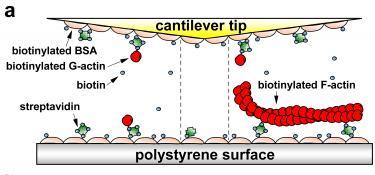Mar 21 2013
Researchers have for the first time demonstrated that mechanical forces can control the depolymerization of actin, a critical protein that provides the major force-bearing structure in the cytoskeletons of cells. The research suggests that forces applied both externally and internally may play a much larger role than previously believed in regulating a range of processes inside cells.
 This diagram shows the atomic force microscope (AFM) experimental equipment used by Georgia Tech researchers to study the bond lifetimes. Credit: Georgia Tech image
This diagram shows the atomic force microscope (AFM) experimental equipment used by Georgia Tech researchers to study the bond lifetimes. Credit: Georgia Tech image
Using atomic force microscopy (AFM) force-clamp experiments, the research found that tensile force regulates the kinetics of actin dissociation by prolonging the lifetimes of bonds at low force range, and by shortening bond lifetimes beyond a force threshold. The research also identified a possible molecular basis for the bonds that form when mechanical forces create new interactions between subunits of actin.
Found in the cytoskeleton of nearly all cells, actin forms dynamic microfilaments that provide structure and sustain forces. A cell's ability to assemble and disassemble actin allows it to rapidly move or change shape in response to the environment.
The research was reported March 4 in the early online edition of the journal Proceedings of the National Academy of Sciences (PNAS). The work was supported by the National Institutes of Health (NIH).
"For the first time, we have shown that mechanical force can directly regulate how actin is assembled and disassembled," said Larry McIntire, chair of the Wallace H. Coulter Department of Biomedical Engineering at Georgia Tech and Emory University and corresponding author of the study. "Actin is fundamental to how cells accomplish most of their functions and processes. This research gives us a whole new way of thinking about how a cell can do things like rearrange its cytoskeleton in response to external forces."
The external forces affecting a cell could arise from such mechanical actions as blood flow, trauma to the body, or the loading of bones and other tissue as organisms move around.
"Forces are applied to cells all the time, and often they are directional, not uniformly applied in a certain direction," said McIntire. "The cell can rearrange its cytoskeleton to either accommodate the forces that are being applied, or apply its own forces to do something – such as moving to go after food."
Because these forces regulate the polymerization and depolymerization of actin, they load the actin fibers in a specific direction, affecting the duration of bonds that may influence cellular growth in one direction, he said.
For instance, tensile forces applied to the actin produce catch bonds, in which the bond lifetime increases as the force increases. These catch bonds have been shown to exist in other proteins, but actin is the most important protein known to form the structures. Most bonds at the cellular level are slip bonds which, unlike catch bonds, dissociate more quickly with application of force.
The researchers used a specially-constructed AFM to conduct their experiments. The tip was coated with actin monomers, while a polystyrene surface below the AFM tip was coated with either monomeric or filamentous actin. To study the catch-slip bonds, the tip was driven close to the surface to allow bond formation, then retracted to pull on the bond. The tension was held stationary to measure the bond lifetime at a constant force.
The research team also used molecular dynamics simulations to predict the specific amino acids likely to be important in forming the catch bonds. Experiments using specialized reagents confirmed the molecular mechanism, a lysine-glutamic acid-salt bridge believed to be responsible for forming long-lived bonds between actin sub-units when force is applied to them.
"What we found was that when you apply force, the force induces additional interactions at the atomic scale," said Cheng Zhu, a Regents' professor in the Coulter Department of Biomedical Engineering and co-corresponding author of the paper. "When you apply force, you find that residues that had previously not been making contact are now interacting. These are force-induced interactions."
Proof that force application can play a role in the internal functions of cells demonstrates the growing importance of a relatively new field of research known as mechano-biology, which studies how mechanical activities affect living tissues.
"We know that the cell can sense the mechanical environment around it," said Zhu. "One of the cell's responses to the mechanical environment is to change shape and reorganize the actin cytoskeleton. Previously, it was thought that sensory molecules at the cell surface were required to convert the mechanical cues into biochemical signals before the actin cytoskeleton could be altered. The mechanism we describe can bypass the cellular signaling mechanisms because actin bears the force in the cell."
The work sets the stage for additional research into other biochemical reactions that may be produced by the application of force.
"It's becoming more and more clear that the ability of the cell to vary its mechanical environment, in addition to responding to what's going on outside it, is crucial to a lot of what goes on with the biochemistry in the cell functions," McIntire added. "If you can change the structure of the amino acids by pulling on them, and that force is applied to an enzymatic site, you can increase or decrease the enzymatic activity by changing the local structure of the amino acids."